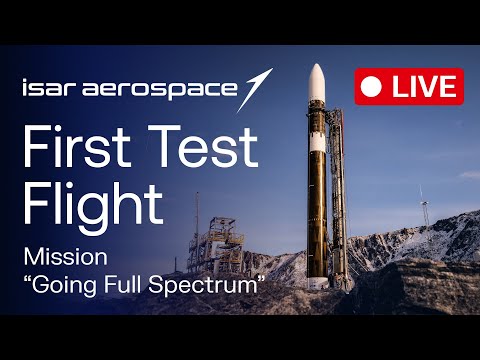Update at 11:30 am is with the details of a press briefing.
Washington – The first launch of the Spectrum rocket of Isar Aerospace failed on March 30 when the vehicle lost the second of the attitude control after takeoff and dropped on Earth, but the company still considered the launch as a successful test flight.
The Spectrum rocket took off Duport Andøya in northern Norway at 6:30 am in the east during the first attempt to launch orbital of a commercial entity in continental Europe outside Russia. The weather conditions had postponed the launch of more than a week. The company had a launch period from March 20 to March 31, established by a license received by the company of Norwegian regulators on March 17.
The vehicle has climbed in a clear sky, but seemed to lose control of the attitude about 25 seconds after takeoff, shortly after the advertiser of the company’s launching webdiffion said that the vehicle would make a pitchover maneuver, designed to allow the rocket to earn a horizontal speed as well as altitude.
In five seconds, the vehicle completely rejected and started to go down. While the webditeuse has moved away from the rocket, an explosion could be heard during the broadcast about 10 seconds later. VG video, a Norwegian publication, showed the rocket striking the surface near the cushion and explodes.
The managers of the company declared during a call with journalists about four hours after takeoff that the vehicle had activated its flight termination system, which closes the engines of the rocket, to the brand T + 30 seconds. The vehicle then fell into an “aerodynamic and stable phase” in an area provided in the waters near the PAD, said Alexandre Dalleau, vice-president of mission and launch operations.
“The PAD looks healthy, which is good,” said Daniel Metzler, Managing Director of Isar Aerospace, on the call.
Officials refused to speculate on what caused the vehicle to be lost. “We have seen that the vehicle was plummeting, so there was a certain form of loss of control,” said Metzler. He said it would be at least a few days before the company could examine data to obtain information on the potential cause, part of an “appropriate survey” which will include Norwegian space authorities and regulators.
Despite half a minute after takeoff, Isar Aerospace called the test flight, which he named “Going Full Spectrum”, a success. “It was a success because we achieved all the objectives we had for this theft,” he said. “We did not reach Orbit, but we learned a ton, and that prepares us very well for the second flight awaits us.”
“With this test, we were able to collect a substantial amount of flight data to apply on our future missions,” said Dalleau, who previously supervised Ariane, Soyuz and Vega from French Guyana. “Even if I would say that the end of the mission was spectacular, I would say – and I insist on this because of my previous experience – it was always a success.”
“We did not expect us to get into orbit” on this test flight, said Metzler on the call. “We have decided to collect data mainly, and that’s something we have succeeded. We have gathered tons of data. “
The second Spectrum rocket is “quite progressive” in production, but he said it was too early to say when the company could be ready for a second launch because it analyzes the data of this flight. “We will make the necessary adjustments and try to return with vehicle number two on the PAD as soon as possible.”
“We are super happy,” he said about theft. “This is the moment that people are proud, for Europe, frankly, to be proud.”

Spectrum is a two -step launch vehicle designed to place up to 1,000 kilograms in low terrestrial orbit and 700 kilograms in synchronic orbit. The first step uses nine of the company’s Aquila engines, powered by liquid oxygen and liquid propane, while the second step uses a single Aquila optimized under vacuum engine.
Isar Aerospace has raised more than 400 million euros ($ 430 million) to date, including more than 65 million euros in an extension of an anterior C series in June 2024. The managers of the company noted before the launch that the second and third Specter Roquettes were in production.
Isar, based in Munich, is one of the many European companies developing small launch vehicles, none of which has reached orbit. Another German company, Rocket Factory Augsburg, was preparing for a first launch of its RFA One rocket from Saxavord Spaceport in the Shetland Islands when the first stage of the vehicle was destroyed during a static shooting test in August 2024.
The failure of the first launch of the specter comes just after the European space agency has launched a competition to support new European vehicles. The ESA launched an appeal to proposals on March 24 for the European launcher challenge, seeking proposals from European companies offering launch services or to modernize launch vehicles. ESA will select a “bouquet” of companies eligible this summer and will seek funds from ESA member states at its ministerial conference in November.
“Success to leave the cushion and a lot of data already obtained. I am sure that @isaraerospace will learn a lot, ”Josef Aschbacher, Managing Director of ESA, poster On social networks just after launching the spectrum. “The launch of the rockets is difficult. Never give up, go ahead with even more energy!”



